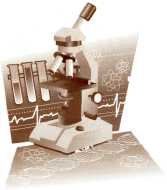 |
Home | Search | Browse | About IPO | Staff | Links |
 |
Home | Search | Browse | About IPO | Staff | Links |
|
T e s t i n g y o u r D N A By Jeanette O'Boyle 
Ruby Grain Porter of DuQuoin had a family legend that her mother's family had Native American ancestry, but her years of genealogical research had failed to prove this. Ultimately, she resorted to molecular genealogy to find her answer. Molecular genealogy compares and matches people by matrilineal DNA, patrilineal DNA, and/or racial percentage tests. Patrilineal DNA is passed from males to males. It is the Y chromosome (males are XY, females are XX) used for patrilineal testing. The Y chromosome is passed complete from father to son without any change. This test provides an analysis of 26 genetic markers (mutations) passed from male descendent to male descendent. These markers were selected because they will remain identical (or identical with only one difference) for 500 generations almost without exception. In all my school classes I have never taken a biochemistry course. In fact, I have never taken a chemistry class. Math was always easy for me so I opted for physics instead. When the idea of testing DNA surfaced about the time of the O. J. Simpson murder trail, it all seemed very confusing to me. I assumed it was because my knowledge of chemistry was zilch. My husband assured me that he had taken a lot of chemistry and the idea of DNA was just as confusing to him. To try to understand something about DNA I read The Seven Daughters of Eve, a book by Bryan Sykes, Professor of Human Genetics at Oxford University in Great Britain (New York, London: W. W. Morton and Company, 2001). This book seemed easy for me to understand. I also "Googled" DNA testing and similar items and read the results, then looked for companies that test DNA for individuals.  This patrilineal test was used to determine if Thomas Jefferson fathered slave Sally Hemmings' son. Thomas Jefferson had no sons who lived so a descendent of his brother was used. Both Thomas Jefferson and his brother would have received identical Y-chromosomes from their father; therefore, a male to male descendent of Jefferson's brother should have identical Y chromosome DNA to the descendent of Hemmings' son if Thomas Jefferson fathered the child. It was identical. Patrilineal DNA is also used to learn if persons descended from a single ancestor. In the article "Who's Your Daddy?" printed in the April 24, 2003 Times-Dispatch of Richmond, Virginia, Wayne Bates of Centreville, Virginia, instigated DNA testing in the family association, Bates Family of Old Virginia. Bates wanted to prove his relations were all descended from John Bates, who arrived in Virginia in 1623. Sixty-five men were tested. Of those tested, 51 had identical Y-chromosomes or were descended from John Bates. Fourteen were not. Among those was Wayne Bates. Matrilineal DNA tests use a person's mitochondrial DNA (mtDNA for short). Every person has mtDNA but it is only passed on through the mother. Your mother inherited it from her mother who inherited it from hers, and so on back through time. Therefore, mtDNA traces an unbroken maternal line back through time for generation after generation. A portion of mtDNA known as HVR-1 is tested to find maternal ancestors. Almost everyone's DNA is identical in this portion; however the differences indicate if you share a common female ancestor. These differences are called markers and are mutations in the DNA. Currently, there are only 33 major maternal lines known, most tell what area or region of the world your female ancestor came from. These regions are based on the theory that all life as we know it began in Africa, and, that those original people migrated via land bridges to other areas of the world. For this reason Dr. Sykes states that all people have a small amount of African DNA. The testing people went around the world and got representative DNAs from all the specific areas. The races/ethnic groups were determined by comparisons of mtDNA. The logic of this hypothesis is listed in Dr. Sykes' book and in other articles. This all sounds great, doesn't it? But a note of caution is advised. Your ancestors double every generation you go backward in time. When you go back 1,000 years, this means you will have many thousands of lines or ancestors with DNA. When you test with mtDNA, you have the results of only one line. This seems like a slender thread on which to base an identity, but future discoveries in DNA research may bring more information for these tests. Several companies offer DNA testing: Family Tree DNA; Relative Genetics; Oxford Ancestors; Gene-Tree; Roots for Real; Ancestry by DNA; Trace Genetics; and African Ancestry. The cost ranges from $159 by Ancestry by DNA to several hundred dollars by the others. The number of markers used in the testing determines price. Last, for those of you still wondering, Mrs. Porter used AncestrybyDNA.com to discover she was 84 percent European, 11 percent Native American, and 5 percent Sub Saharan African. She did have a Native American in her mother's ancestry. Jeanette O'Boyle of Murphysboro writes for the newsletter of the Southern Illinois Genealogical Society, where a version of this article first appeared. 20 |ILLINOIS HERITAGE |
|
|